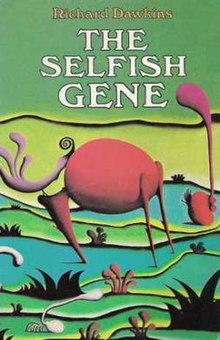Opening paragraph, of a chapter called “Why are people?”
Intelligent life on a planet comes of age when it first works out the reason for its own existence. If superior creatures from space ever visit earth, the first question they will ask, in order to assess the level of our civilization, is: ‘Have they discovered evolution yet?’ Living organisms had existed on earth, without ever knowing why, for over three thousand million years before the truth finally dawned on one of them. His name was Charles Darwin. To be fair, others had had inklings of the truth, but it was Darwin who first put together a coherent and tenable account of why we exist. Darwin made it possible for us to give a sensible answer to the curious child whose questions heads this chapter. We no longer have to resort to superstition when faced with the deep problems: Is there a meaning to life? What are we for? What is man? After posting the last of these questions, the eminent zoologist G.G. Simpson put it thus: ‘The point I want to make now is that all attempted to answer that question before 1859 are worthless and that we will be better off if we ignore them completely.’
Here’s a classic nonfiction work I hadn’t read until this past week. (Though I’ve had a copy for decades, and also recently acquired its 40th anniversary edition, expanded with detailed notes.) I’ve said more than once that, in a sense, it’s not worth reading older nonfiction books when newer ones might have superseded them. Perhaps an exception to this rule is for books that do have some classic status, that were influential in their time, that are still cited in bibliographies of so many later books. As one might now read Darwin, knowing how much has been discovered since his time.
This book was published in 1976, while Dawkins was a zoologist at Oxford, long before he became famous as a public intellectual. (That he especially in these days of social media sometimes commits gaffes that attract detractors should not diminish the content and significance of this and his many later books.)
It’s known now perhaps primarily for establishing the idea of a ‘meme’, a cultural counterpart to the biological gene. But that idea is in the last chapter, almost as an afterthought. Upfront, he states that the book isn’t about Darwinism in general, but about the biology of selfishness and altruism.
His major idea is that natural selection is best understood at the level of the gene, and the early chapters describe the idea of replicators (like DNA), of competition, of how our genes are replicators that survive inside us and use us as ‘survival machines’. As are all plants and animals. He goes into considerable detail about chromosomes, sexual reproduction, cell division, mutations. He admits that his very specific definition of a gene is not one every biologist would agree with, but it makes his claim that natural selection operates at the level of the gene correct.
He repeatedly challenges various claims about ‘group selection,’ especially the idea that animal behavior might cause one to sacrifice itself ‘for the good of the species,’ an idea common among certain writers of the earlier 20th century.
An interesting reflection in Chapter 4 is about the difference between plants and animals. To paraphrase: Plants move slowly; animals are fast, and to move fast, developed functions analogous to punched cards in machines: nerve cells or neurons connected to thousands of others, drawn out into axons, bundled together as nerves, a cluster of them forming a brain, that coordinate the control of muscles to the sense organs that detect events in the outside world. In primitive organisms these connections are direct; in higher beings the brain, with its memory, intervenes. The impression of purposiveness is what we recognize as consciousness…
The bulk of the book examines behaviors that do not seem to obviously support the survival of individual organisms — Aggression, altruism, the fallout in ideas first explained in the 1960s and which by now are common currency: kin selection; why aggression; competition between siblings, and between parents and children; and the differing strategies of fathers and mothers. Likely no one before Dawkins had, in a book for general readers, spelled out the remorseless logic of how natural selection explains such behavior – or even had revealed that such behavior exists. A key concept is the “evolutionary stable strategy” or ESS, a term from John Maynard Smith, to understand how proportions of populations evolve into stability — males vs female; aggressors vs pacifists.
The final chapter introduces a new kind of replicator, which he dubs a meme. Culture, e.g. language, evolves, changing over time in ways that often seem progressive. Memes are units of culture that spread through brains. He consider why the idea of god can become stable in a cultural environment, by providing psychological appeal, or how ideas of hell-fire and faith survive because blind faith can justify anything, thus propagating ideas of faith, and of patriotic and political beliefs.
He notes how a person’s genetic endowment disperses quickly in a few generations, while a person’s contribution to culture – his memes – can last centuries or millennia.
And finally, he notes how humanity has the capacity of foresight, and perhaps for genuine altruism – that is, we can consciously use foresight to overcome the selfish excesses of our genes. We alone can rebel.
\\
On his final point, I often find it ironic that social conservatives, who reject evolution, so often behave in ways that perpetuate the selfish behaviors our genes have endowed us with. I could go on…





